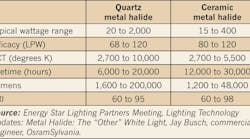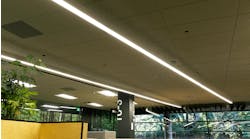The high-intensity discharge (HID) lamp offers a host of benefits for a broad range of lighting applications, even as the LED revolution in lighting continues apace. Although subsequent legislation allowed specialty ballasts, the Energy Policy Act of 2005 eliminated the manufacture and import of mercury vapor (MV) ballasts, thus making the MV system obsolete. The lighting industry can anticipate that either Congressional legislation or a Department of Energy (DOE) rulemaking action will eliminate MV lamp making. The two remaining HID lamp types are the metal-halide (MH) and the high-pressure sodium (HPS) source, and just about all of the technology development and market potential today centers around the MH source.
Technology snapshot
The MH lamp consists of an arc tube surrounded by an outer bulb envelope, which isolates the arc tube from the environment and blocks any ultraviolet radiation. Made of either quartz or ceramic glass, the arc tube contains a mixture of argon, mercury, and metal-halide salts, thereby offering color temperatures from 1,800K to 10,000K and a color rendering index (CRI) of up to 98.
Generally unaffected by ambient temperature and equally suited for extreme temperatures, the MH lamp can achieve up to a 24,000-hour average rated life and an output from 1,200 lm to 200,000 lm. The maximum practical efficacy of a “white-light” MH lamp (80 CRI) is about 230 lm/W. Like all arc lamps, the MH lamp needs a ballast to provide the starting voltage to the lamp, current limitation during warm-up, and a constant current during run time. As the lamp warms up, the current decreases while the voltage and power increase. Eventually, the lamp AC voltage stabilizes, and the lamp power is regulated to the proper level.
Beefing up the ballast
A big improvement over the traditional magnetic MH core and coil ballast, which operates at 88% efficiency, is the solid-state electronic ballast, or e-ballast, offering up to 97% efficiency. Using a high-frequency or low-frequency square-wave system and other advanced waveforms, the e-ballast provides higher lumen maintenance, longer life, fault mode protection, and improved power regulation. It also allows for continuous dimming, better color control, and no stroboscopic effect. The ballast’s open-circuit voltage requirement is reduced to the operating requirements of the lamp, creating lower ballast operating temperatures, increasing ballast life, and reducing maintenance/replacement costs.
The original method for starting the MH lamp, called the probe-start method, uses an operating electrode at each end of the arc tube and a starting probe mounted close to one of the operating electrodes. To begin lamp operation, a discharge is created across the small gap between the starting probe electrode and the nearby operating electrode; eventually, an arc stream is created between both operating electrodes, and a bi-metal switch removes the starting probe electrode from the circuit. Each time the MH lamp is turned on, tungsten sputters from the electrodes. Over time, the tungsten deposit causes the arc tube wall to blacken, reducing lamp performance.
A major improvement in MH lamp operation is the pulse-start arc tube, which uses an igniter within the ballast to deliver a high-voltage pulse directly across the electrodes to start the lamp. By eliminating the probe and the bi-metal switch — components that are often prone to failure — the pulse-start lamp offers a number of benefits, such as increased lumen output.
The Energy Independence and Security Act of 2007 eliminated probe-start magnetic ballasts in new 150W to 500W MH fixtures, so the only available choice for this range of wattages is the pulse-start lamp, using a quartz or ceramic (polycrystalline alumina) arc tube, which is often referred to as a ceramic or CMH lamp (similar to the HPS arc tube). Ceramic MH arc tubes are up to five times shorter than an HPS arc tube and about half the length of a quartz arc tube.
Ceramic MH lamps, now available in a variety of configurations, including PAR20, PAR30, PAR38, and T6, provide greater light output, improved color rendering, and limited color shift compared to the probe-start lamp.
Most MH lamps are designed to operate in a specific burning position, such as horizontal, vertical with base up, or vertical with base down, and when operated in burning positions other than those specified, can result in severe reduction in lamp life, lumen output, and changes in color.
The vertical position screw-base MH lamp is primarily used in downlights. The horizontal position screw-base MH lamp often has a bowed arc tube and uses a position-fixing pin in the base, called a prefocus or position-orienting mogul (POM) base. This base and matching socket assure correct positioning of the lamp. Because these lamps are mostly used in outdoor lighting, the smallest wattage product available is 175W. Special versions for signs and sports lighting are also available.
A “universal” position lamp is the most versatile type; however, it provides about 10% less light output than a position-specific lamp and has a more restricted range of color temperatures.
Safety concerns and the NEC
Because of its high operating temperatures (900°C to 1,100°C) with contained pressures of 5 atmospheres to 30 atmospheres, the MH lamp potentially can experience an arc tube rupture. If an arc tube breaks, hot particles could be ejected from the lamp. Generally, all MH lamps reach their end of life passively. However, MH lamps that are continuously operated without being switched off can experience arc tube rupture, although such occurrences are rare. Manufacturers recommend group relamping at, or before, rated end-of-life rather than doing spot-relamping.
Some manufacturers offer automatic cycling controllers, which can be as simple as a time clock, to turn a lamp system on and off, using either an arranged calendar schedule or on a random basis.
In response to the possibility of MH lamp rupture, the 2005 National Electrical Code (NEC) included specific rules for MH luminaires (except for thick-glass PAR lamps), requiring them to be either enclosed or to have some physical means to ensure that only Type-O lamps can be used in them. O-type lamps have a protective glass sleeve over the arc tube. E-type lamps are acceptable only in suitably rated enclosed luminaires, in accordance with UL 1572 and CSA C22.2 No. 9.0. Finally, S-type lamps are limited to specific models in the 350W to 1,000W range, in open luminaires, when the lamp is operated in a near vertical position. All listed luminaires have lamp/relamp information on a label affixed to the luminaire, showing the specific lamp to use.
Any interruption in the power supply, or even a serious voltage dip for a few cycles, will cause an MH lamp to lose arc conduction, and several minutes are needed for the lamp to restart, since the arc tube has to cool and the internal vapor pressure must decrease to the point that the arc can restrike. This restrike time and the warm-up period can cause of a delay of up to 15 minutes before the return to full light output.
To address this problem, the NEC requires some form of a back-up lighting system, such as an integral tungsten-halogen lamp connected to an emergency power source, if power is momentarily interrupted to certain HID lighting systems. In addition, a ballast component called a hot restrike device can be specified for some single- and double-ended MH lamps. Thus, a hot restrike accessory can restart the MH lamp’s arc almost immediately after a momentary voltage dip.
Controls for the future
Since the list of mandatory control requirements grows with each edition of the ASHRAE/IESNA 90.0 standard, inserting control capabilities (wired and wireless) into an MH luminaire allows changes in lumen output (such as a 50% reduction) based on input from occupancy sensors, switches, or some other input, such as scheduling software, resulting in a cost-effective strategy.
Obviously, there’s great potential for energy savings by expanding the use of MH lamps and by aggressively pursuing further efficiency milestones.
SIDEBAR 1: Next Generation Energy Concerns
Many commercial building energy codes have energy savings rules for outdoor lighting. For example, ASHRAE/IES 90.1 2010, the IECC energy-efficient code, and some model ordinances call for outdoor HID ballasts to have some type of bi-level light output and/or dimming capabilities. Additionally, California Title 20 product regulations require 150W to 500W MH fixtures to have a specific level of ballast or fixture efficiency or to have automatic energy-saving lighting controls.
For these reasons, bi-level control systems for area or street lighting are finding increasing application. Housed in the top surface of a luminaire, a node can communicate via radio, satellite, and/or cellular system to a central operating center, delivering control and status messages to a web page. This allows an operator to control, adjust, monitor, and receive maintenance messages from each luminaire on the system.
SIDEBAR 2: MH Improvements on the Horizon
The Department of Energy has identified 10 subject areas where an emerging technology can improve the performance of HID light sources, and some are commercially available today, such as the electrodeless lamp. Continuing research on materials, coatings, arc tube shapes, electrodes, fill chemistry, lamp/ballast waveforms, and thermal management should also lead to a boost in MH performance. Mercury-free MH lamps are currently available as automobile head lights; however, the elimination of the mercury fill results in lower efficacy. Nevertheless, this reduction in efficacy will hopefully be overcome in the future. Some lighting industry leaders would like to see the Environmental Protection Agency’s Energy Star program expanded to include HID products.
SIDEBAR 3: Benefits of Ceramic Metal-Halide (CMH) Lamps
• Highly controllable point source of light
• Wide range of wattages from 15W to 400W in elliptical, tubular, linear single and
double ended, and reflector shapes.
• Recent technology advances in medium-wattage ceramic MH enable 24,000-hour
rated life, CRI up to 94, and luminous efficacies of 120 lm/W.
• Consistent color over life, with two color temperatures (3,000K and 4,200K).
• High lumen maintenance (near 90%).
• CCTs range from 1,800K to 10,000K.
• Smaller and lighter than comparable SSL systems.
• Universal burning position for most lamp types.




